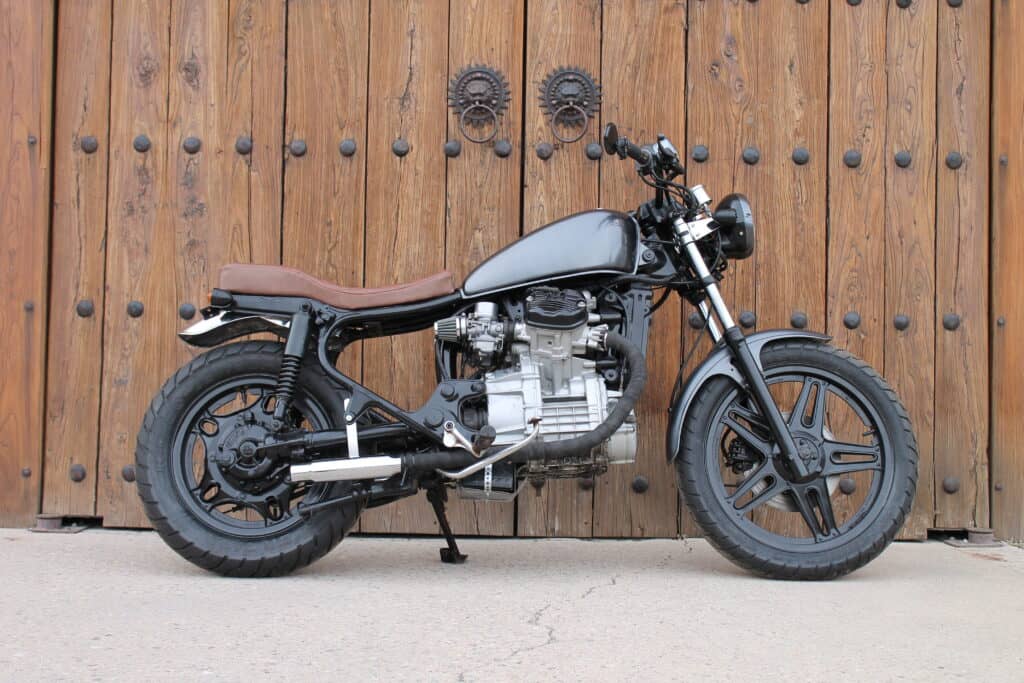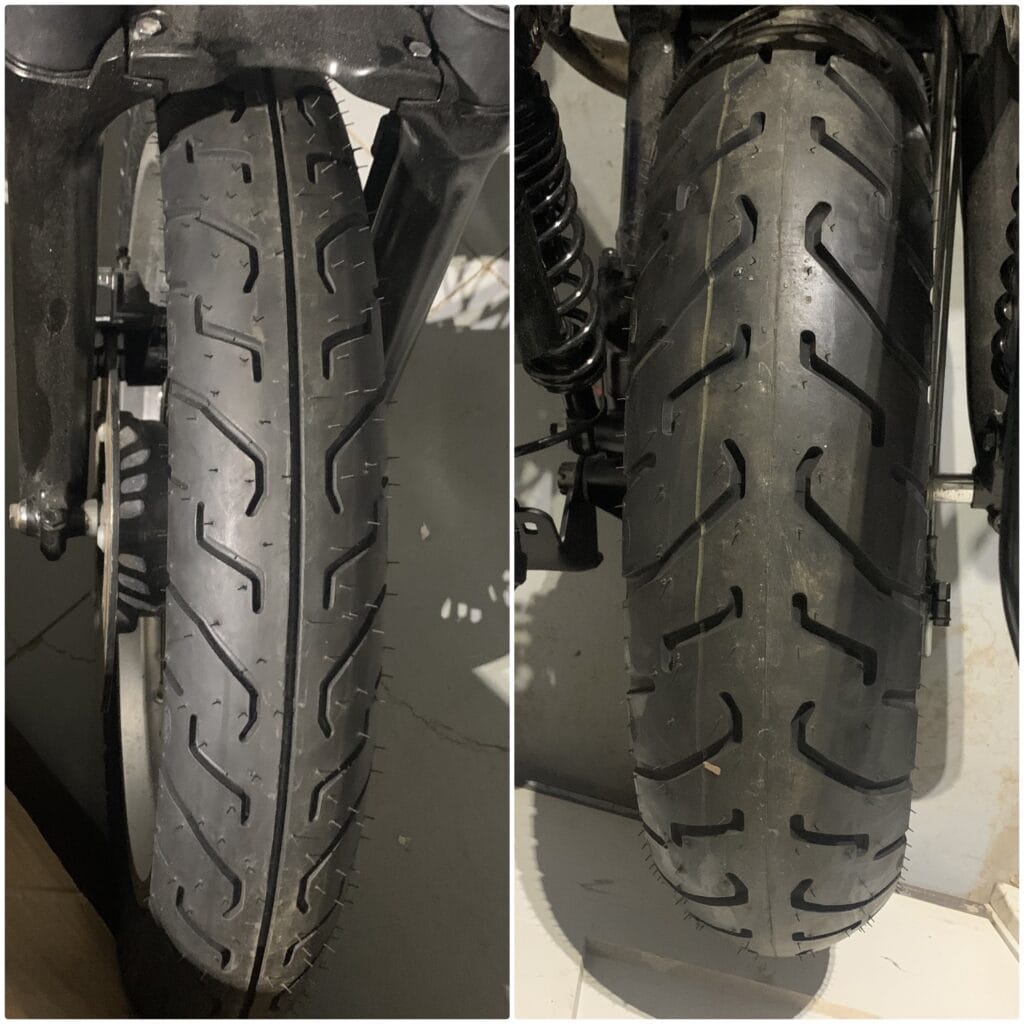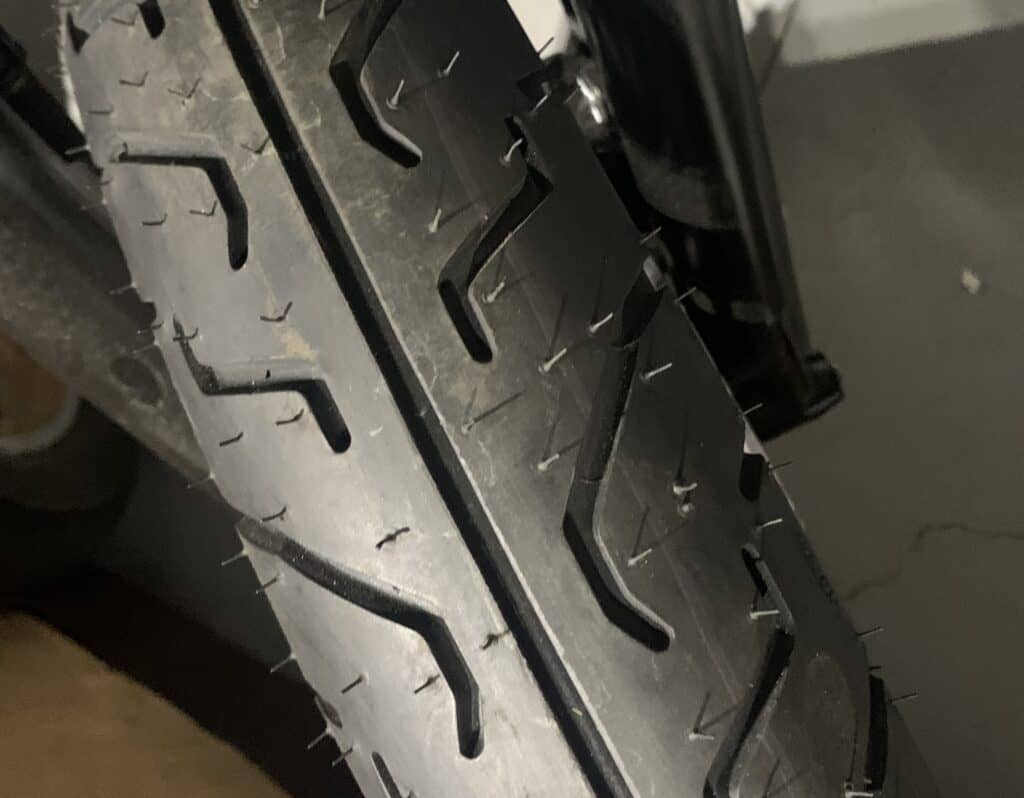
You may have noticed that the two wheels on a motorcycle are different sizes. Most of the time, you’ll see motorcycles with taller and thinner front tires with shorter and wider back tires.
Some people assume it’s for looks while other people don’t even notice the difference in sizes. But there’s a reason the wheels on motorcycles are slightly different from each other.
So, why do motorcycles have different size wheels? Most motorcycles have larger front wheels, meaning they’re bigger in diameter and skinnier, to help with movement and steering. The back wheels are shorter in diameter and wider to help with traction and control of the motorcycle since that is where the power is coming from.
Having restored dozens of motorcycles myself, getting to know motorcycle tires and the “why” behind their engineering was a priority to me to ensure I completed my restorations safely. For a more in-depth explanation (and to understand why you probably shouldn’t use just any tires on your motorcycle), keep on reading.
Understanding Different Motorcycle Wheel Sizes
Anyone would assume that motorcycles can run just fine if they had two wheels that were the same size. In fact, it seems that would make life a lot easier for most motorcycle riders because you’d only need to worry about finding one sized tire in case either of them became flat.
The idea of motorcycles have been around since the late 1800’s, but motorcycles didn’t really start becoming popular until the first world war which is when production took a serious increase. This is because an effective, fast way to communicate with the front line troops was needed. After that, the production of motorcycles continued to become more and more popular in society.
You’ll notice most motorcycles made in the early 1900’s had the same sized tires. But as time went on, engineers and manufacturers tested and tried the efficiency and safety of motorcycles which eventually evolved into the way motorcycles are made today.
The main function of the front wheel is to take impact and steer the motorcycle. Having a taller, skinnier front tire greatly helps with this functionality. The skinnier the tire, the more sensitive the motorcycle is to turning.
You can compare this to laying coins on their side; if you put a penny on it’s side, it will tip over much easier than a nickel would. That’s simply because the nickel is wider than the penny. Compare the front tire to the penny.
The front wheels have a larger diameter to take and manage impact better. The larger size gives the motorcycle better stability and handle in possible rough roads which ultimately protects the rest of the motorcycle (and the rider).

The back wheels of a motorcycle are “smaller,” meaning they have a shorter diameter and are usually wider than the front wheel. The power the motorcycle engine produces is all given to the back tire which is essentially what makes the motorcycle move. The wider the back tire is, the more surface area there is that touches the road which means more traction.
Most of the weight of the motorcycle is put on the back wheel. So the wider wheel also provides a bit of stability to handle the motorcycle and maintain the weight that it’s holding.
Can I Use Wheels Different From Manufacture Recommendation?
There are many different ways you can modify motorcycle wheels to make them look different and/or the way you want. Such changes include painting the rims or getting different looking tires. While some modifications to wheels are okay, one change you should stay away from is getting different sized tires from what the manufacturer says to get. Varying from different brands is totally fine.
Motorcyclists sometimes try to use the same sized tires for both sides, switch the tires they already have between the front and back, or simply get way bigger or smaller tires than what were already on the motorcycle. While it’s possible to get away with these modifications, this can produce several safety hazards.
As I mentioned previously, I have restored dozens of motorcycles and owned a restoration business. I bought some pretty rough project bikes and saw all sorts of abuse done to them. One common one was previous owners installing the wrong size of tires. I’ve seen first-hand what this can do to a motorcycle.
If you buy bigger wheels than what you originally have, those wheels can rub on the frame and wiring. Buying tires that are too small also run a safety risk to you and your motorcycle. Smaller sized tires may not be able to handle the weight and maneuvering of the motorcycle which can cause a blowout. A blowout while out on a ride can be catastrophic.
Aside from these risks, getting different sized tires outside of manufacturer recommendations also means you probably have to get different sized rims. That’s a pretty expensive modification if you ask me.
Many people also wonder if it’s possible to switch up the tires, meaning using the rear tire in the front. It is possible, but there are some rules regarding this. You can learn more about this by reading our other article here.
Why Motorcycle Tires Feature Reverse Tread Patterns

When you buy a new set of motorcycle tires, you’ll notice that aside from their size, they look different from each other with their tread pattern. This is common and pretty normal on motorcycle wheels. The question is why does the tread looks different and why are they in opposite directions from each other?
On motorcycles tires, the front and rear are specified on them as well as what direction they go in. You can’t simply mount motorcycle tires on the rim and assume they’re interchangeable with the direction they go. Motorcycle tires are built a specific way with a tread to goes a specific direction.
The front and back wheels of a motorcycle experience different forces. As it was said earlier, the back wheels deals with acceleration and power while the front wheel deals with steering and impact. The treads on these different wheels were made the way they are for these very reasons.
The tread on the rear wheel was created in a pattern to repel water. This keeps more traction on the road when the road is wet and prevents hydroplaning.
The treads on the front wheels of motorcycles do a similar function but for a different reason. The tread pattern was also created in a way that repels water because the front tire is what takes the most pressure and force while a motorcycle is braking. Repelling water during this time is important because that front tire needs as much traction as possible to make sure the motorcycle stops when you need it to.
Do I Need To Replace Both Tires If One Goes Out?
We know that having the correct type and size of tires for your motorcycle is important. Keeping them in sync is vital to the life of your motorcycle as well as for your safety.
But what if one tire goes out while the other one is perfectly fine? Luckily, there are no serious repercussions of changing one motorcycle tire while keeping the other, as long as the other one is in decent shape.
Some might think that when one goes out, you have to change both of them because the amount of worn tread they have has to be the same. While that may apply to cars, it’s not as important with motorcycles since there are only two wheels involved instead of four.
It’s also not a big deal if you buy a different brand of tire from the tire that’s remaining on your motorcycle. Again, just make sure you buy the right size of tire that is compatible with your motorcycle.
Conclusion
Motorcycles have different sized tires for functionality and rider safety. The front tire is taller and skinnier for steering and impact purposes while the back tire is shorter and wider for traction and power purposes.
Now that you understand the “why” behind these different sized tires, my hope is that you’ll be an even safer motorcyclist and be able to share your knowledge with your fellow riders!
Related Questions
What should you do to the tires when storing a motorcycle? If motorcycle tires aren’t properly stored, they can quickly get flat spots and brittle. Make sure to move the motorcycle a few inches every few weeks and maintain the tire pressure, or elevate the tires. You can find more information I wrote about this by clicking here.
How often should I check my motorcycle tire pressure? You should check your motorcycle tire pressure every time you take your motorcycle out for a ride. If you forget before you ride, you should check the tire pressure at least once every 1-2 weeks during the riding season.
